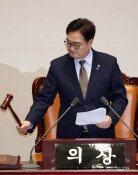KEPCO to invest 11 trillion won in wind power generation project
KEPCO to invest 11 trillion won in wind power generation project
Posted December. 21, 2019 08:37,
Updated December. 21, 2019 08:37

The Korea Electric Power Corporation (KEPCO) has announced that it will invest some 11 trillion won to build an offshore wind power plant complex in Sinan County, South Jeolla Province, starting in 2020, which would be the largest of its kind in the country if completed. The project is intended to increase the share of renewable energy and create more jobs in the region, but controversy is expected to flare up over whether it is an appropriate time for KEPCO to make such a huge investment.
The Ministry of Trade, Industry and Energy, KEPCO, and South Jeolla Province held a ceremony at Lotte Hotel Seoul on Friday to mark their agreement on the development of the large wind power plant project in Sinan. Under the deal, the complex with a maximum capacity of 8.2GW (gigawatt) will be established near the island of Imjado in three phases by 2029. The total project cost stands at around 48.5 trillion won.
South Korea’s largest electric utility company will take part in the first phase to build the wind power generation complex and facilities for the transmission and transformation of electricity. While the first-phase project with a capacity of 3GW is expected to cost 20 trillion won, KEPCO will cover 11 trillion won of the total cost. South Jeolla Province and KEPCO will form a consortium this year along with private companies interested in the project, and begin construction in 2023 after on-site inspections scheduled for next year.
The wind power generation complex to be created in Sinan is a signature project that has been actively sought by Kim Yung-rok, the governor of South Jeolla Province. In August, the provincial government revealed its own model for job creation based on the wind power project participated by labor and management, private businesses, and local autonomous entities, saying that the project would create around 110,000 jobs. In July, President Moon Jae-in also traveled to the region as part of his tours of non-Seoul areas and was briefed about the province’s vision for “Blue Economy.”
However, apparently overwhelmed by the huge project cost, private operators had been reluctant to join the project, slowing down the pace of progress. This is when KEPCO stepped in. The public company decided to construct basic infrastructure for transmission and transformation facilities, so that private operators that would use them could pay partial compensation for KEPCO.
A government official said that “KEPCO seems to have judged that once the project kicks off, private businesses would have less financial burden to join the project, which would speed up the pace of progress.”
Still, some say that the electric utility’s investment of 11 trillion won will only accelerate the company’s financial burden while it has been already experiencing financial difficulties. KEPCO suffered an operating loss of over 900 billion won in the first half of the year (from January to June), the worst-ever first-half record in seven years. The company managed to get back in the black in the third quarter of the year, but the growth rate of its operating profit was the slowest since 2011.
“KEPCO decided to make an investment because it expected that the project would be profitable based on their review of its feasibility,” an official at the ministry said.
Choong-Hyun Song balgun@donga.com







